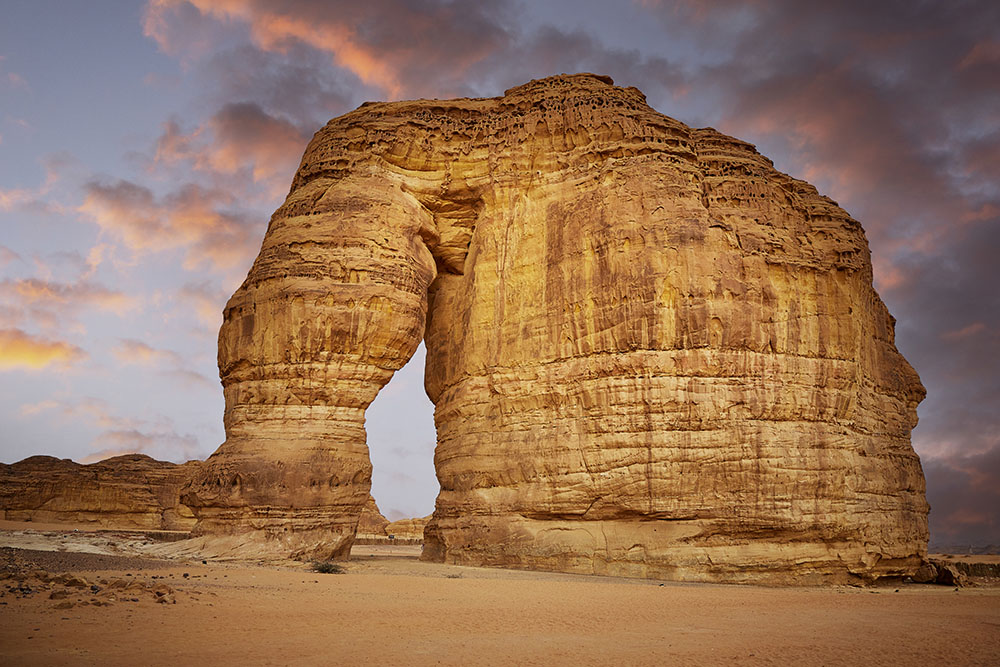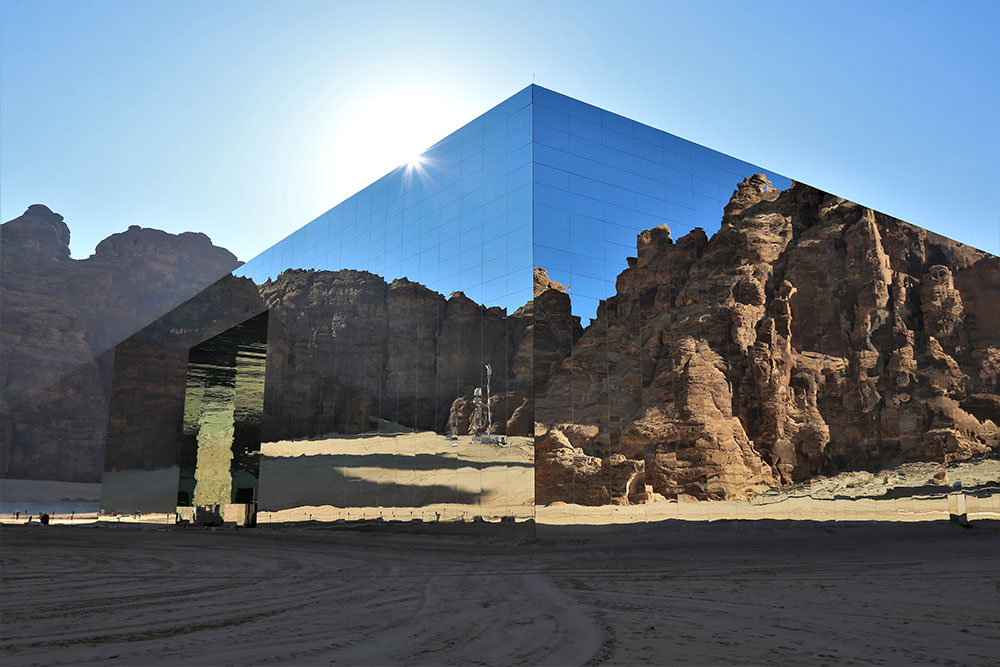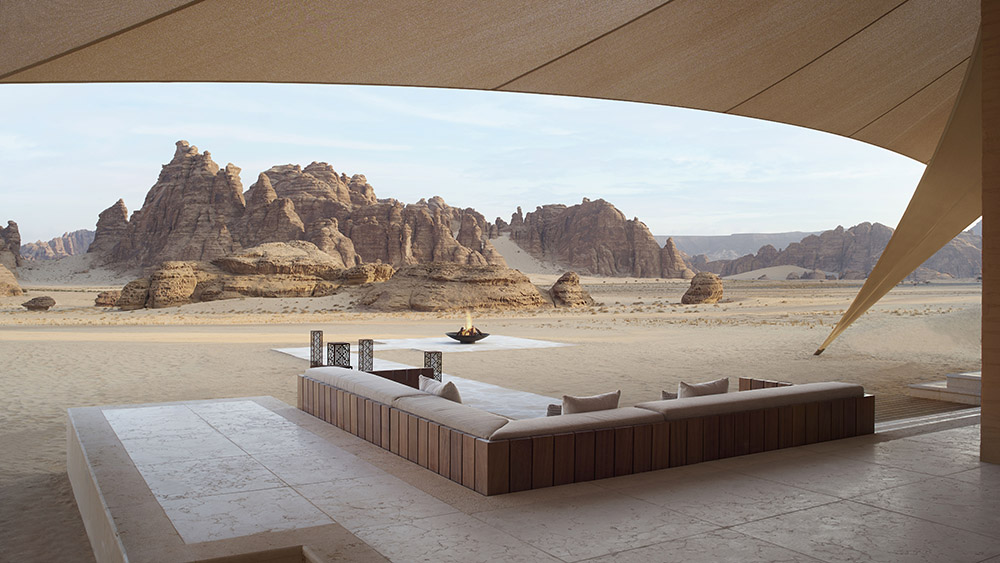Crossroads of Culture
AlUla is an ancient archaeological site in an extraordinary landscape where heritage, nature and art meet.
By Nicola chilton
AlUla’s energy is exhilarating, almost intoxicating. It radiates out of the geological formations, created over aeons by shifting tectonic plates and erupting volcanoes. It can be felt in the 200,000 years of human history that runs through the place. It’s carried in the birdsong and the water that flow through the oasis, where two million date palms and citrus trees provide shade and sustenance for humans and fauna, as they have for millennia. The ancient civilisations who made AlUla their home must have felt this energy too, breathing it into the stories they left behind in the form of petroglyphs and stone-hewn tombs. Today, they’re the main draws to this remote stretch of desert 1,100 kilometres northwest of the Saudi capital, Riyadh.
AlUla has been a crossroads of cultures for centuries. The Nabataeans, the architects of the more famous tombs and ancient city at Petra in Jordan, used AlUla to control the frankincense trade routes that crossed the Arabian peninsula en route to Egypt, Mesopotamia and the Mediterranean, amassing huge wealth. With the advent of Islam, AlUla became a popular stopping point on pilgrimage routes. Today, AlUla is at another crossroads.


Hero image: Carved out of a solitary rock, the Tomb of Lihyan, Son of Kuza is the largest and most impressive in Hegra, but this tomb was never finished. Elephant Rock is one of AlUla’s geological marvels. Unlike the ornate facades of Hegra’s Nabataean tombs, this sandstone monolith was shaped by natural forces. Bottom, Maraya, in the Ashar Valley, is the world’s largest mirrored building. Tomb and Elephant Rock photos: Xavier Arnau/iStock; Maraya: Courtesy of Royal Commission for AlUla.
As Saudi Arabia embarks on an ambitious plan to welcome 100 million tourists a year by 2030, AlUla is at the forefront of the country’s fledgling tourism industry. This quiet oasis town of 67,000 people is seeing the arrival of curious visitors from around the world, as well as new hotels, high-end restaurants, and extraordinary contemporary art, a counterpoint to the ancient forms left behind by previous inhabitants.
The landscapes of AlUla, both natural and man-made, are unique. Wind and water, perhaps the greatest artists of all, have carved curious shapes into the terrain. Extraordinary rock features resemble elephants, fish, and human faces. The sands of Gharameel are punctuated by stone pinnacles that look like molten wax. In the Ashar Valley, the undulating curves of soft sandstone cliffs contrast with the reflective surfaces of Maraya, the world’s largest mirrored building, designed by Milan-based studio Giò Forma.
It was in this same valley that Desert X AlUla, a site-responsive contemporary art exhibition, first brought together 14 influential Saudi and international artists in 2020, including eL Seed, Lita Albuquerque and Zahrah Alghamdi. Five of the works created for the event are still on display in the grounds of the Habitas hotel that was subsequently built on the site.
But journey back a couple of millennia, and other artists were using these landscapes as their canvas. The rock face of Jabal Ikmah, a mountain near to the ancient city of Dadan, a caravan way station, is covered in thousands of inscriptions in ancient, pre-Arabic languages recording offerings and pilgrimages, as well as pictographs of animals, musical instruments and items used in daily life. Some were carved by professional scribes, others by ordinary people. The oldest date back to the 9th and 10th centuries BCE.
Two sophisticated early civilisations—the Dadanites and Lihyanites, present in AlUla between the 9th and 2nd centuries BCE—left their marks in even more sophisticated ways. They carved tombs and lion-shaped sculptures into the mountains, as well as human statues, one of which—a 2.3-metre-high sandstone statue presumed to be a Lihyanite king—is currently on loan to the Louvre in Paris.

Banyan Tree AlUla’s all-villa resort offers spectacular views of one of the world’s newest and most mysterious
travel destinations. It is inspired by the natural surroundings of the Ashar Valley. Photo: Banyan Tree AlUla.
Next came the Nabataeans who left behind AlUla’s real masterpieces—127 stone-hewn tombs spread across the sands of Hegra and listed as a UNESCO World Heritage Site in 2008, the first in Saudi Arabia.
The tombs can be visited today under the stewardship of the Royal Commission for AlUla (RCU), an organisation established by the Saudi government to safeguard and make accessible the region’s heritage. Saudi storyteller guides, called rawi—trained by international museums and mentored by archaeologists—bring the sites to life for visitors. Suleiman Aljuwayhil, a former rawi and now a member of the RCU’s destination marketing team, explains that Hegra was the Nabataeans’ southern capital, and their “moneymaker”.
“The Nabataeans were nomads who became traders,” Aljuwayhil explains. “Frankincense was like the oil of its time because it was used in every temple in the ancient world, from Rome to Mesopotamia.” The traders commissioned masons to carve tombs from the stone for themselves and their descendants. The wealthier the owner, the more ornate the facade. Adornments like cornices and columns were adopted from the civilisations they had come into contact with. For Aljuwayhil, inscriptions in many of the tombs is where “it gets really interesting. This tells us who the owner was, who could be buried here, which era it fell into, and the penalties and curses that would befall those buried without permission,” he says.
Some tomb facades feature an eagle atop a pediment flanked by two urns, representing the Nabataean god Dushara and the path from life to the afterlife. Others include the head of Medusa and rows of lotus flowers.
Carved out of a solitary rock, the Tomb of Lihyan, Son of Kuza is the largest, most impressive and most recognisable. Four columns flank the entrance. But this tomb was never finished; rough, unrefined chisel marks skirt its lower third (Nabataeans worked from the top, down). The reason for that, as with so much of AlUla, is a mystery.


Now You See Me, Now You Don’t, an artwork created for the inaugural Desert X AlUla by Saudi artist Manal AlDowayan, has been integrated into the grounds of the Habitas hotel. Bottom, the old town’s recent habitation gives researchers living memories to work with. Trampoline photo: Royal Commission for AlUla; Old town: Johnny Greig/iStock
The Nabataeans flourished in AlUla for only 200 years before it was annexed by the expanding Roman Empire, in 106AD, under the emperor Trajan. Gradually, Nabataean identity was erased, and little to document the civilisation was left. But AlUla continued to be a major crossroads on pilgrimage and trade routes long after, as evidenced by the sophistication of AlUla’s old town, a labyrinth of mud-brick houses, inhabited from the 1200s until the 1980s.
Saudi archaeologist Aljohara Almudra has been part of the team excavating the old town since 2020. Unlike other long-abandoned heritage sites, the old town’s recent habitation gives researchers living memories to work with. “We’re documenting and saving this heritage and these traditions for the people who lived [here], so they can be proud of their history,” Almudra says.
The stories of the old town’s inhabitants help archaeologists understand how people lived, and why it was built the way it was. Local lore says the town went through a constant process of rebuilding and repair, with families relocating to their oasis farms during the summer and returning to the old town in winter. But even with oral histories to build on, there’s still a huge amount that remains unknown. “We’re just at the start,” Almudra says.
Also drawn to the old town and its stories is Saudi artist Manal AlDowayan. She has visited more than 25 times and says she is “addicted to the place and its people”. The artwork she created for Desert X AlUla, Now You See Me, Now You Don’t, is in the grounds of the Habitas hotel and has become an integral part of the landscape. Guests are welcome to interact with the artwork. A cluster of trampolines hidden behind dramatic rock outcrops, the work represents environmental challenges and climate change, an issue that hit home when AlDowayan first saw palm trees dying due to falling water tables. It was the ephemeral nature of a puddle seen on a visit to AlUla that inspired her.
“I was looking at this humongous puddle next to the Tomb of Lihyan, Son of Kuza, and it was reflecting the mountains and the tombs in pink,” she says. “When I came back the next day, it was gone. I started thinking about what the humble puddle would say to us today, and I thought it would say ‘now you see me, now you don’t’. That’s the idea behind the artwork.”
AlDowayan’s next project in AlUla, titled Oasis of Stories, is part of Wadi Al Fann, a 65-square-kilometre site opening in 2024 that will house permanent site-specific works by major global artists, including James Turrell and Agnes Denes. Oasis of Stories is inspired by the people of AlUla old town, and the connection between humans and their history. “These are the people who consider the Nabataeans their ancestors, so their stories are mixed up with the heritage stories. It’s very emotional,” AlDowayan says.
Every time she comes to AlUla, she asks its inhabitants the same questions. What was life like growing up, how was the weather, what did you eat, what did you see, what were your songs, what did your grandmother tell you about the tombs? AlDowayan says the real story isn’t the walls of the old town but the custodians of this extraordinary place.




